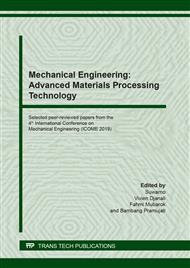p.62
p.68
p.75
p.82
p.91
p.98
p.103
p.109
p.117
Effects of Oil Palm Empty Fruit Bunch and Magnesium Oxide Volume Fraction on Mechanical Characteristics of Railway Brake Block Composite Material
Abstract:
Railway brake block is one of the most important components of the braking system of a railway vehicle. Materials for railway brake blocks are commonly made from metal or composite. The metallic brake blocks have some disadvantages that are heavy, low wear-resistant and has potential in generating a spark. While the composite brake blocks do not have those disadvantages. Natural fiber from oil palm empty fruit bunches as the waste from the production of palm oil can be used as a composite constituent. This composite brake blocks made from oil palm empty fruit bunches as reinforcement, phenol resin as matrix, and alumina, magnesium oxide and iron powder as a friction modifier. Density, hardness, coefficient of friction, compressive strength and flexural strength tests were carried out to determine the mechanical characteristic of the composite railway brake block material. The railway brake block test results consist of the density of 1.96 g/cm3, the hardness of 57.6 HRB, coefficient of friction of 0.43, the compressive strength of 37.1 MPa, and flexural strength of 33 MPa. There are three samples of volume fraction combination with 20% of oil palm empty fruit bunch in sample 1, 15% oil palm empty fruit bunch in sample 2 and 10% oil palm empty fruit bunch in sample 3. Percentage of MgO is adjusted to compensate the volume fraction of oil palm empty fruit bunch in the sample. Sample test results show that composite with volume fraction 10% of oil palm empty fruit bunch, phenolic resin of 30%, Al2O3 of 25%, MgO of 20%, iron powder of 15% has better mechanical properties for the alternative composite railway brake block material as compared to the other two.
Info:
Periodical:
Pages:
91-97
Citation:
Online since:
October 2020
Authors:
Price:
Сopyright:
© 2020 Trans Tech Publications Ltd. All Rights Reserved
Share:
Citation:


